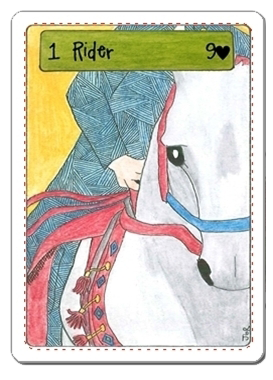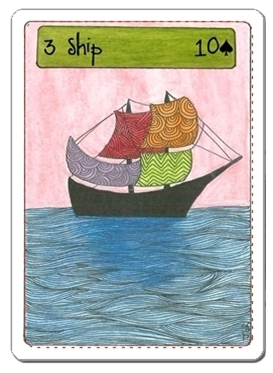Tarot Journaling
“Journaling is one of the easiest and most powerful ways to accelerate your personal development. By getting your thoughts out of your head and putting them down in writing, you gain insights you’d otherwise never see.” – Steve Pavlina
Have you ever wanted to write a book on the subject of tarot? A book that reflects your own thoughts and personal experiences as you journey through each of the 78 cards? Well, that’s pretty much what you’ll end up with if you decide to start a tarot journal. It will become your own personal masterpiece as it grows, filled with your insights and intimate discoveries of this magical arcana.
Journaling is a powerful tool designed to assist in developing our tarot abilities and to record our thoughts on each card as we meditate upon them. Journaling allows us a wide degree of creativity too while we have fun exploring what our subconscious mind reveals to us about each card that we include in our journal.
There are many streams of thought on how to approach a tarot journal, the do’s and don’ts, the many tips and ideas, even resources; and we will look at the best of those in this article. But first we should think about the value of a tarot journal. Why would we want to keep a tarot journal, and how could it possibly benefit us in our quest to uncover more about the deep and mystical system commonly known to us as tarot.Â
For someone like me who is a serious tarot enthusiast, it is easy to become quite overwhelmed by all the books and information available on tarot while attempting to learn more about these cards. However, our tarot journal becomes our own personal book on tarot, comprised of our very own thoughts and feelings about each card. Yes, we draw inspiration from the many works available on tarot, and even include some of these – like commonly accepted keywords or inspirational verses – but the objective of keeping a tarot journal is so that we can record our own personal experiences with the tarot. It is here that the value of a tarot journal becomes clear. When we look back on our journal after contributing to it for a while, we will be surprised and positively delighted at how our understanding of tarot has grown and how so much of our notes are born from our own personal journey. In effect our journal becomes our very own volume on tarot, unlike anything that can be bought!
Inevitably this brings us to the point where we are sitting in front of our new blank journal, and we have no idea where to begin! Have a look at some of the ideas, tips and resources that I have listed below, I am confident that you too will find a starting point here.
Some experienced journal-keepers use only a pencil to write in their journals. The thinking behind this is that it keeps us unafraid to make mistakes and therefore uninhibited with our thoughts as we explore each card. Others prefer to use a 3-ring binder, often with dividers between sections. These sections could include personal readings, spreads, shamanic journeying and images. If you are anything like me you too would prefer actual paper, however many tarot journal-keepers prefer to keep an electronic journal instead. Decide what style would suit you best to begin your journal, but do not allow this to become a distraction or reason for procrastination. It is better to begin, even modestly at first, than to keep putting it off in search of the ‘perfect’ leather-bound blank journal. Remember, the value of your journal is in the journey and the personal revelations that you will receive as you engage in the process. What it looks like - aesthetically pleasing or not – is of less importance.
When deciding on how to organise my own tarot journal I fell in love with, and consequently decided to use, Rachel Pollack’s “Blessings for the Major Arcana.†She wrote a short blessing for each of the majors, which I decided to use as an introduction to the cards in my journal. As an example of her work, here is her blessing for The Fool card: Fool—Blessed are you, Ignorant One, who leads us forward, in brightness and joy. Isn’t that gorgeous? I love the tone that it sets on an otherwise blank page. I also decided to create a comparison sheet, so that I could examine cards from multiple decks simultaneously. I would list the obvious things that all or most have in common, and then I’d devote a paragraph per card to additional insights gained from the extra imagery that the individual decks reflect, which has added greatly to my understanding and readings.
One of the most powerful additions to my own tarot journal however has come in the form of simple line drawings of the Rider Waite Smith tarot deck that I was able to download and print from the internet. You can trace your own if you wish, using tracing paper over the card. I meticulously colour each element of the card in my own choice of colours, and in doing so I have discovered insights that I had not previously noticed! For example, the 3 of Swords card in the RWS deck, which is a large red heart into which 3 swords have been plunged. Until I coloured the line drawing of this card I had not noticed that the swords were sharp upon entering the heart but blunt upon exiting it! This detail led me to surprising and new insights that have added depth to my understanding of this card. So too The Fool card, it was only when colouring it that I suddenly noticed the head of an eagle deliberately depicted on the backpack over the Fool’s shoulder. As you can imagine this opened new windows of insights and understanding for me on that particular card.
Do remember to have fun as you play and record your thoughts in your new journal. Your insights and understanding of the cards are every bit as valuable and valid as any published author’s is, I dare say that yours is and should be even more so – for you! In time, your tarot journal will become a volume of personal tarot insights from which you will learn and from which you could probably even teach!



Tarot journalling is such an important part of the learning experience. I definitely recommend it to others and I found it personally helped me to learn the cards. It personalises it and it helps the card meanings become ‘real’.
I created a Tarot Workbook / Journal that you can either print out or type into on your computer. For every card, you can write your thoughts on the general meanings (upright and reversed) and more specific meanings such as relationships, money, career, spirituality, etc. It might be of interest to you or your readers who would like a workbook format for their Tarot journal. You can find out more at http://www.biddytarot.com/tarot-guides/workbook/
Thanks Biddy, I love your work! xxx
I agree, drawing and/or coloring a deck can’t help but bring new insight.